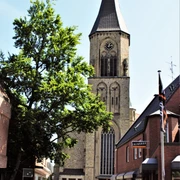In the heart of Rhede, the neo-Gothic St. Gudula's Church dominates the townscape like no other building. Built in 1901 according to plans by Hilger Hertel, it impresses with red machine-made brick, sandstone decorations and a 77.5 metre high tower complete with St Christopher figure. The interior houses a rich collection of neo-Gothic art, original stained glass windows from 1901-1903 and numerous pieces from the previous church, including Baroque paintings, a Romanesque baptismal font and a figure of the church's patron saint from 1520. The organ with 3,576 pipes and seven bells complete the ensemble. A place with an impressive history and a special atmosphere.
The history of St Gudula's Church in Rhede dates back to the 12th century. Its current location was once the site of a small private church founded by the noble von Rhete family. Over the centuries, the sacred building was constantly extended and adapted to the needs of the growing congregation. The medieval hall church was structurally altered over many generations - until it finally became too small to fulfil the requirements of the time.
At the end of the 19th century, the decision was made to demolish the old building. In 1898, the Gothic church was completely demolished. In its place, a new, imposing church was built in just three years: today's St Gudula's Church, designed by the renowned architect Hilger Hertel. On 12 June 1901, Rhede celebrated the inauguration of the neo-Gothic building, which still dominates the centre of the town today.
Despite the radical new building, the past remains alive: Numerous works of art and liturgical artefacts from the previous church were carefully retained. A Romanesque baptismal font, an oak relief from the early 16th century and baroque altarpieces by the Coesfeld artist Hermann Veltman are still part of the interior today. The statue of St Gudula from 1520 has also found its place in the new church interior.
The art-historical significance of the church is not only reflected in its architecture, but also in the preserved glazing from 1901 to 1903, the handmade floor tiles by Philipp Baum and the exceptionally well-preserved neo-Gothic furnishings. The organ from 1998 and the seven-part peal of bells, the oldest of which dates back to the 15th century, combine past and present in a sonorous way.
St. Gudula's is exemplary for the history of church architecture in the Münsterland region - with roots in the Middle Ages, a powerful awakening in the era of historicism and the conscious preservation of historical values to this day.
Good to know
Openings
st-gudula.de
Payment methods
Directions & Parking facilities
By car:
Coming from the A3 motorway:
Take exit 5 Hamminkeln in the direction of Bocholt
Turn right onto Isselburger Str./B473
Turn right onto Hüttemannstr. (2.4km)
At the roundabout take the fourth exit (Bocholter Str.)
Continue for 2.2km on Dingdener Str.
Turn right onto Birkenallee
Follow the road to Rhede
St Gudula's Church is located in the northern part of the town
Coming by bus/train:
Option 1 starting at Münster (Westf.) local and long-distance railway station:
Bus route S75 direction Bocholt, bus stop "Rhede, Ludgerusschule"
12 min walk to the church
Option 2 starting at Münster (Westphalia) local and long-distance railway station:
Bus route S75 in the direction of Bocholt, stop "Borken, Westfalen"
Continue with bus line R51 in the direction of Bocholt to the stop "Rhede, Gudulakirche"
Parking
Parking is available directly at St Gudula's Church. On weekdays you can park free of charge for 2 hours with a parking disc.
More information
Rhede offers ideal conditions for cyclists: an idyllic park landscape, well-developed cycle paths and the proximity to the Bocholter Aa invite you to enjoy relaxed tours. Historic farms, small watercourses and neighbouring towns such as Bocholt are easy to reach by bike.
Various signposted themed cycle paths offer interesting cycle tours through the Münsterland region.
The routes run just a few metres from the church:
100 Castles Route | West Course
Flamingo Route
Hohe Mark Route
The route starts at junction 56, just 100 metres from the church.
With over 4500 kilometres of junction network, even those unfamiliar with the area can easily navigate and find their way around the region's cycle paths and themed routes.
Contact person
Kirche Sankt Gudula
Author
Münsterland e.V.
License (master data)
Nearby






